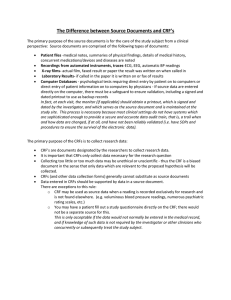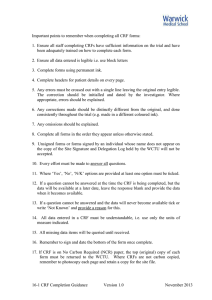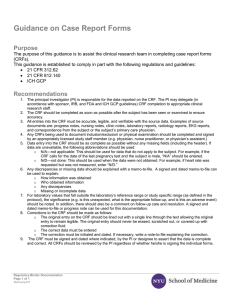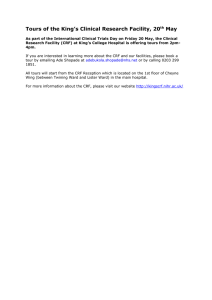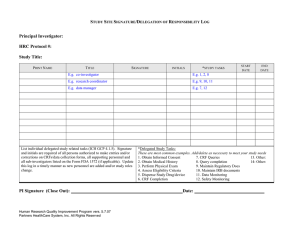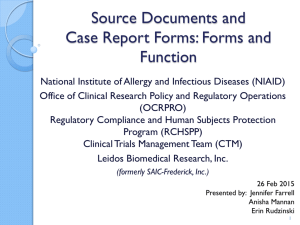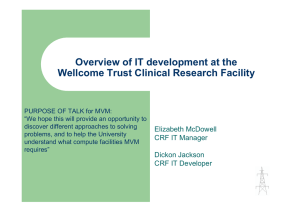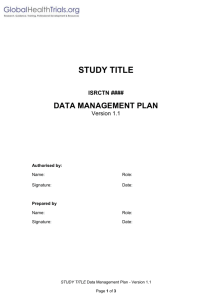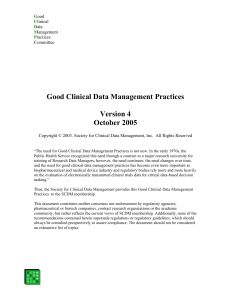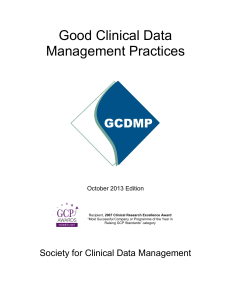The Clinical Research Center Research Practice Manual Guidelines
advertisement
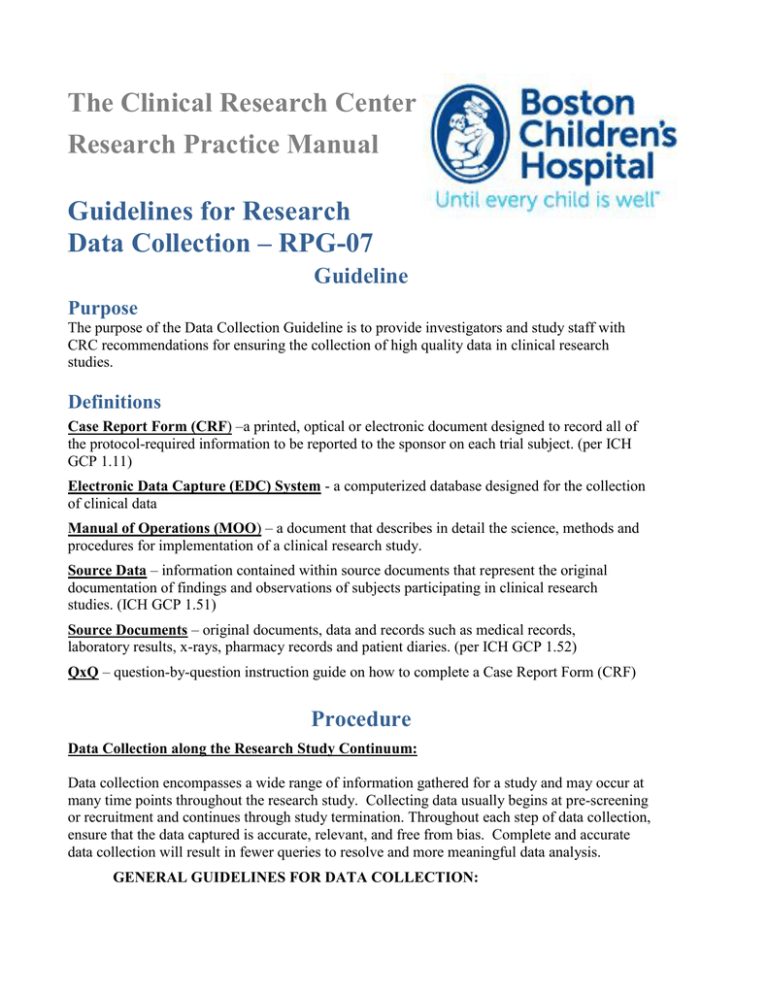
The Clinical Research Center Research Practice Manual Guidelines for Research Data Collection – RPG-07 Guideline Purpose The purpose of the Data Collection Guideline is to provide investigators and study staff with CRC recommendations for ensuring the collection of high quality data in clinical research studies. Definitions Case Report Form (CRF) –a printed, optical or electronic document designed to record all of the protocol-required information to be reported to the sponsor on each trial subject. (per ICH GCP 1.11) Electronic Data Capture (EDC) System - a computerized database designed for the collection of clinical data Manual of Operations (MOO) – a document that describes in detail the science, methods and procedures for implementation of a clinical research study. Source Data – information contained within source documents that represent the original documentation of findings and observations of subjects participating in clinical research studies. (ICH GCP 1.51) Source Documents – original documents, data and records such as medical records, laboratory results, x-rays, pharmacy records and patient diaries. (per ICH GCP 1.52) QxQ – question-by-question instruction guide on how to complete a Case Report Form (CRF) Procedure Data Collection along the Research Study Continuum: Data collection encompasses a wide range of information gathered for a study and may occur at many time points throughout the research study. Collecting data usually begins at pre-screening or recruitment and continues through study termination. Throughout each step of data collection, ensure that the data captured is accurate, relevant, and free from bias. Complete and accurate data collection will result in fewer queries to resolve and more meaningful data analysis. GENERAL GUIDELINES FOR DATA COLLECTION: Before beginning data collection • Familiarize yourself with the following documents/tools: CRFs (Know which fields are required and understand the flow of the CRF using the skip logic provided.) Source documents (Know where the source data comes from.) Data collection instructions in the MOO Other data collection tools (i.e., Training Manuals, QxQ) Have training sessions on how to collect data on CRFs and EDC systems Note: Only trained and authorized staff should complete data collection. During data collection • Use assigned Study ID numbers on all forms. Do NOT record patient identifiers on CRFs (i.e., Name, Medical Record Number [MRN], Social Security Number [SSN]). • Record the Study ID on every page of the CRF. This helps prevent loss of data if the pages of the CRF are separated. • Collect data during the participant‟s study visit or as soon as it is available (i.e., lab results from electronic medical records). • Follow all case report form instructions carefully. • Use only the most currently approved version of CRFs. • All forms should be completed in black ballpoint pen unless otherwise specified (i.e., No.2 pencil for fill-in-the-bubble questionnaires). Felt-tip pens and markers should be avoided as the ink can bleed into paper or can run if it touches water. • Record data in free-text fields clearly and legibly. Ensure the spelling is correct. • Use only study-approved abbreviations to avoid serious clinical and research errors. • For numeric data fields, record data to the specified number of decimal places. Use leading and trailing zeros when indicated. • When errors occur, draw a single line through the incorrect entry and write the correct entry above or near the original entry. Initial and date the change. It is important not to obscure the original entry. Do not scratch-out the incorrect entry or use correction fluid or tape to fix errors. • Only capture data in the specified fields of the CRF. Avoid writing notes in the margin. Writing in the margins should be limited to error corrections and explanations relating to corrections. If elaboration of a response provided on the CRF is necessary, and there is no „other‟ or „comment‟ field to provide the information, a „Note to File‟ is recommended. • Obtain PI signatures, if specified on the CRF. • If data for a field is not available, use acceptable notations as described in the coding instructions to account for whether it is Not Applicable, Not Done, Unknown or Missing. The CRC uses the following codes to indicate different instances of unavailable data: Code Description -3 Not Applicable -5 Not Done / Refused -8 Unknown -9 Missing Immediately following data collection • Review CRFs for completeness and accuracy immediately following data collection. If data are incomplete, try to obtain the information before the subject leaves the study visit. • If using an EDC system, enter the data captured on CRFs within 3 days of collection. • Follow study quality assurance procedures as documented in the study Manual of Operations. • Keep CRFs in the appropriate study folders in a locked drawer or cabinet. Source documents should be stored separately form the CRFs. Other Information: The ALCOA principle for source documents – Accurate, Legible, Contemporaneous, Original, Attributable, Complete, Consistent, Enduring and Available is a Good Clinical Practice. Here is a link for examples and an easy-to-read summary on Good Documentation Practice in Clinical Research: http://www.ncbi.nlm.nih.gov/pmc/articles/PMC3121265 References Guidance for Industry E6 Good Clinical Practice: Consolidated Guidance. April 1996. ICH. 4 March 2009 <http://www.fda.gov/cder/guidance/959fnl.pdf> Woolen, SW. The Facts about Source Documents. June 29, 1999. DIA Meeting. 4 March 2009 <http://www.fda.gov/cder/present/dia-699/wollen-dia99/wollen-dia99.ppt> The Society for Clinical Data Management. “CRF Completion Guidelines” June 2008. Good Clinical Data Management Practices. 4 March 2009 <http://www.scdm.org/gcdmp/> Kolman J, Meng P, Scott G. “Case Report Form (CRF) Completion” Good Clinical Practice. John Wiley and Sons, Ltd. 1998. Fonds de la recherché en santé du Québec “How to Fill in a Case Report Form (CRF) and Modify Data” 2006. Standard Operating Procedures to Ensure Good Clinical Practice at Clinical Research Sites. 4 March 2009. <http://www.frsq.gouv.qc.ca/en/financement/SOP.shtml> Document Attributes Title Guidelines for Research Data Collection – RPG-07 Author Ellen McCarthy, MPH Date of Origin October 2010 Reviewed/ Revised by Ellen McCarthy, MPH Dates Reviewed/Revised 08/28/13 11/14/2014 Copyright ©Boston Children‟s Hospital, 2014 Last Modified 11/14/2014 Approved SIGNATURE ON FILE Stavroula Osganian, MD, ScD, MPH Chief, Clinical Research Center Acknowledgement: The following CHB staff made substantive contributions to the development of this Guideline: Sarah Krathwohl, Handan Titiz, Tracy A. Antonelli. Disclaimer: Should Hospital and CRC policies conflict, Hospital policy will supersede CRC policy in all cases.
